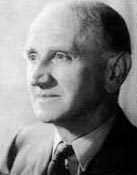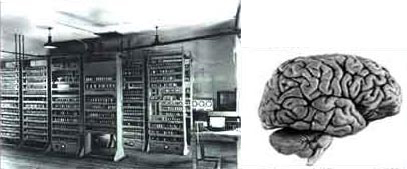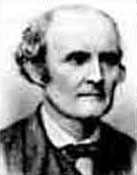Student Resource: study ideas, questions and activities (pdf)
Alexander Aitken was the greatest mathematician of his era and possessed an astonishing computational brain that could complete challenges that today are reserved for the most complex computers. As one of the most remarkable mathematical brains of all time, Aitken could recite Pi to 707 decimal places, multiply two nine digit numbers in his head in 30 seconds, and render fractions to 26 decimal places in under five seconds.
Phenomenal Memory and Brain
Almost mystical acts, which would appear more at home as part of a magic show, were put to use by Aitken to advance mathematical knowledge and impress amazed undergraduates at Edinburgh University, Scotland, where he spent most of his working life.
Aitken’s phenomenal skill in mental arithmetic made him the greatest mental calculator for whom there is any reliable record. In psychological tests in Britain in the 1920s he took thirty seconds to multiply 987,654,321 by 123,456,789 and produce the correct answer: 121,932,631,112,635,269. Asked to render the fraction 4/47 as a decimal, he waited four seconds and answered: “Point 08510638297872340425531914 – and that’s as far as I can carry it.”
 He had such a prodigious memory that he could store away solutions to problems and then call on them from his brain when needed. He could do a series of calculations by mental arithmetic and hold the answers to all of them in his head long enough to bring them all together at the end and have the final answer.
He had such a prodigious memory that he could store away solutions to problems and then call on them from his brain when needed. He could do a series of calculations by mental arithmetic and hold the answers to all of them in his head long enough to bring them all together at the end and have the final answer.
Legacy of Knowledge
Aitken’s mathematical work was in statistics, numerical analysis and algebra. In numerical analysis he introduced the idea of accelerating the convergence of a numerical method. He also introduced a method of progressive linear interpolation. In algebra he made contributions to the theory of determinants.
His main mathematical interests were in Actuarial Mathematics, Linear Algebra, Numerical Methods and Statistics. Econometricians have benefited especially from his applications of matrix algebra to problems in numerical analysis, as well as his statistical contributions to the theory of linear models. Dr. David Giles, currently teaching in the Department of Economics at University of Victoria (Canada) writes that, “Every student of Econometrics must be indebted to Alexander Aitken”. Econometricians also use the Generalised Least Squares (“Aitken”) estimator when this model has a non-standard error covariance matrix.
He published on such topics as symmetric groups, invariants, the solution of linear and polynomial equations, eigenvalue problems, and computational algorithms. The statistics paper “On the Estimation of Statistical Parameters” (co-authored with H.C. Silverstone, 1942) has been most influential and his books, “Determinants and Matrices”, and “Canonical Matrices” (with H.W. Turnbull) are classics in their field.
Numerical Epiphany
Aitken was born in Dunedin, New Zealand on 1 April, 1895, and attended Otago Boys’ High School from 1908 to 1912. He was not a child prodigy: arithmetic bored him and he did badly in it at school until he was nearly 14 years old. Then he experienced some sort of numeric epiphany, during a mathematical lesson by a good teacher at Otago Boys. After that, the whole subject came into focus and he became absorbed by figures.
Aitken writes:
“Only at the age of 15 did I feel that I might develop a real power and for some years about that time, without telling anyone, I practised mental calculation from memory like a Brahmin Yogi, a little extra here, a little extra there, until gradually what had been difficult at first became easier and easier.”
He had the distinction of gaining first place in the nationwide University Scholarship Examination of 1912.
He then studied at the University of Otago in 1913, 1914, and 1918, but his studies were cut short by active service during the First World War. He enlisted in 1915 and left New Zealand with the Sixth Reinforcements and served with the Otago Infantry. He served in the Gallipoli landing, Egypt, and in France where he was wounded in the Battle of the Somme in France. After three months in hospital he was sent back to New Zealand in 1917. His wartime experiences were to haunt him for the rest of his life.
During the war he astounded his fellow soldiers by his ability to memorise, amongst other things, the numbers on their rifles. While serving in the Otago Company at Armentires, the platoon book was destroyed. Aitken recited the names and numbers of all members of his platoon.
Horror of War
His memoir, Gallipoli to the Somme: Recollections of a New Zealand Infantryman (Oxford University Press, 1963), is regarded as one of the most moving accounts of the appalling reality of life in the trenches during the Great War. The infantrymen were very much the spearhead in the battles and young Aitken saw at close quarters the grimness of trench fighting. Long afterwards he described vividly one bombardment in France when shells crumpled into the frontline, with red flames shooting up almost continuously, and it seemed impossible that anyone could survive. He saw in one low dugout four signallers dead at their telephones without a mark on them. They had been killed by shock waves.

His account of fighting as an ANZAC speaks with a human voice that astutely articulates not merely the rational absurdity of war, but also the tightrope between emotion and detachment that a solider had to negotiate:
“… I slid the rifle-sight to ‘450’, aimed and fired.[…] The Turk plunged into the trench in a swirl of dust … This, of course, was what I was there for, but it seemed no light matter, and kept me awake for some time. I would come to no conclusion except that individual guilt in an act of this kind is not absolved by collective duty nor lessened when pooled in collective responsibility. I further found that I bore the Turk no trace of enmity – nor for that matter did any of us; he was to us “Johnny Turk” or “Joe Burke”, almost a fellow sufferer. We were not indoctrinated against him, as we had been against the Germans by propaganda, the cartoons of Louis Raemakers, and tales of atrocity. But I saw, still further, that this Turk, at the moment of shooting, had not even been a person; he might have been big game. It was a single step to the thought that certain ‘colonial’ campaigns, not infrequent in our annals, might have been conducted in almost this game-hunting spirit. Here I balked; to become analytical might lead to doubt of the cause for which we were fighting; for this had been called, in those early years, the ‘war to end war’. I was far from such doubt then, and would have repudiated pacifism.”
Following his return to New Zealand and recovery, he achieved, in 1918, First Class Honours in Latin and French and (remarkably) Second Class Honours in Mathematics. Aitken followed his original intention and became a school teacher at his old school, Otago Boys’ High School. His mathematical genius bubbled under the surface and, encouraged by the new professor of mathematics at Otago University, Aitken gained a post-graduate scholarship which took him to Edinburgh University, Scotland in 1923. He studied for a Ph.D. at Edinburgh under Sir E T Whittaker, one of the most distinguished of British mathematicians. Aitken’s Ph.D. thesis on the smoothing of data was considered so outstanding that he was awarded a D.Sc.

Old College Quadrangle, Edinburgh University
From Calculator to Contributor
In 1925 he was appointed to Edinburgh where he spent the rest of his life. His initial position was Lecturer in Statistics and Mathematical Economics. After encounters with mechanical calculating machines that made his extraordinary mental powers unnecessary, Aitken’s interests matured. At 28 he was at the peak of his calculating abilities, but from lightening fast calculations his focus began to shift to the theoretical. In describing his period of recovery from a small operation in 1934, Aitken writes:
“The nights were bad, in the daytime colleagues and other friends visited me, and I tried to think about abstract things, such as the theory of probability and the theory of groups – and I did begin to see more deeply into these rather abstruse disciplines. Indeed I date a change in my interests and an increase in competence, from these weeks of enforced physical inactivity.”
He became a Reader in Statistics in 1936, the year he was elected a Fellow of the Royal Society. Ten years later, in 1946, at the age of 51, he was appointed to Whittaker’s chair in Mathematics. Aitken is without a doubt a hero on the edge, but his advantage was not just metaphorical – at Edinburgh he was mentor to a number of renowned mathematicians including one of the Twentieth Century’s leading geometers, one William Leonard Edge.
Appointed Fellow of the Royal Society in 1936, Aitken won the Royal Society of Edinburgh’s prestigious Gunning Victoria Jubilee Prize in 1953 for original work in Physical Mathematics, as well as honorary degrees from the University of Edinburgh and the (then) University of New Zealand.
Aitken wrote several books: The Theory of Canonical Matrices (1932) was written jointly with H.W. Turnbull, (the University of St. Andrew’s mathematician who made an extensive and noted contribution to the study of algebraic invariants and quadrants). With D.E. Rutherford he was editor of a series of University Mathematical Texts which have enduringly remained on required reading lists for mathematics students world-wide. His solo-authored papers, “Determinants and Matrices” (1939) and “Statistical Mathematics” (1939) formed pivotal contributions to their field.
Diverse Talent and Brilliant Teacher
Alexander Aitken was a man of great and disparate talents. A champion high-jumper into his late twenties, he was also a writer and a poet. He was devoted to music and was regarded as a fine violinist and viola player, as well as being an occasional composer. Aitken explained his arithmetic technique as dividing numbers into sets of five and “submitting them to German waltz time.” The Edinburgh University psychologist Dr. Ian Hunter, who studied Aitken in the 1920’s, noted that numbers appeared to him as a tune, “like a Bach Fugue”. Dr. Hunter reported that his calculating actions, before analytic or biological interpretation, appeared as reflexive and automatic as those of a boxer or an expert typist.

Alec Aitken
Alexander Aitken is remembered as a warm and gentle man, and a brilliant lecturer. A student at Edinburgh in the early 1960’s recalls:
“Professor Aitken’s first year mathematics lectures were rather unusual. The fifty minutes were composed of forty minutes of clear mathematics, five minutes of jokes and stories and five minutes of ‘tricks’. For the latter Professor Aitken would ask for members of the class to give him numbers for which he would then write down the reciprocal, the square root, the cube root or other appropriate expression.”
While impressing students, the rational stretch of Aitken’s mind would not have made him friends with casinos or lotteries – another idiosyncratic memory of Aitken’s ‘stories’, as part of his lectures on probability, was a rather stern warning about the evils and foolishness of gambling.
It is believed that extraordinary acts of genius in computation, such as those performed by Aitken and also exhibited in autistic people, come from an obsessional, almost morbid concentration. Aitken makes it sound simple, stating that he breaks problems down into the simplest elements. “If I see a motor car with registration number 731, I cannot help observing that it is 17 times 43. Sometimes I find myself squaring the numbers on the lapels of the bus conductors.”

The University of Cambridge EDSAC computer c.1957 versus the brain
To think that everyone can achieve such feats as Aitken by ‘thinking harder’ is a little misleading. Aitken’s innate advantage in performing the unbelievable computations was his mind-boggling memory. When he examined the pages of a mathematical journal he only had to scan it page by page, turning the pages over at a rate at which the ordinary reader would record only the first dozen lines or so. Subsequent discussion made it apparent that he had registered all the material – as he often claimed, he never forgot what he had once seen. Despite the incredulity and admiration he fostered, he was modestly pragmatic about his own abilities as a mathematician:
“Familiarity with numbers acquired by innate faculty sharpened by assiduous practice does give insight into the profounder theorems of algebra and analysis.”
Haunting Memories
The root of Aitken’s genius was also his curse. Aitken’s memories of the war did not fade and his horrific recollections of the battle of the Somme lived with him as real as the day he experienced them. He wrote of them near the end of his life, aged 68 in “Gallipoli to the Somme”. It is believed these hauntings contributed to the ill health he suffered, and eventually led to his death in Edinburgh, Scotland, on 3 November, 1967, aged 72.
He was acclaimed by his peers as the greatest living mathematician and regarded by his mentor, the pioneering Cambridge and Edinburgh mathematician Sir E.T. Whittaker, as the greatest mathematician since Arthur Cayley.

Arthur Cayley
Cayley was a Cambridge mathematician who played a leading role in founding the modern British school of pure mathematics. He was the first to formally develop matrices and made a vast contribution to mathematics. Cayley’s name is given to the operations tables in number systems. He was the recipient of nearly every academic distinction that can be conferred upon an eminent man of science: honorary degrees from most notable universities, election as fellow or foreign corresponding member of the academies of several countries, and the Copley Medal in 1883 from the Royal Society of London.
Alexander Aitken was born in 1895, the year that Arthur Cayley died. He was a man whose world was filled by numbers. For such a rare person, whose extraordinary mind and memory was predicated on an ability to elucidate numeric progressions, the comparison with Cayley has a sure poetic symmetry.
The annual student award given by the New Zealand Mathematics Society, the ‘Aitken Prize’ is named in Alexander Aitken’s honour, and in 1995, at Otago University, a conference was held in his honour, to commemorate the centenary of his birth.
Do it Yourself
The following is extracted from the diverting site Mental Muscles , created by two cognitive scientists from the US, who run through some ‘toning exercises’ for the brain. Their (and no doubt Aitken’s) maxim is “It is not enough to have a good mind. The main thing is to use it well.” (Rene Descartes, 1596-1650).
Mental Muscles
A great mathematician, mental calculator, and all-around genius, Alexander Craig Aitken committed data to memory with incredible speed and accuracy by noticing how new data is somehow related to other data already in memory. He also relied on an “auditory-rhythmic memory” of numbers, but in addition had a gift for imbuing even the most arbitrary-seeming data with rich relationships to other facts and patterns. Thus, he described his associations with the number 7 in terms far richer than a simple visual or auditory image:
The line of poetry ‘They passed the pleiades and the planets seven’ – mysteries in the minds of the ancients — Sabbath or the seventh day – religious observance of Sunday — 7 in contrast with 13 and with 3 in superstition — 7 as a recurring decimal .142857 which, multiplied by 123456, gives the same numbers in cyclic order — a poem on numbers by Binyon, seen in a review lately – I could quote from it. (Hunter 1977:163)
Could you learn to perform mental calculations as quickly and flawlessly as Aitken? For example, could you learn to multiply 2 three-digit numbers – say, 123 by 456 — in two seconds? We return to Aitken’s own remarkably self-aware account of his method in a passage from a biographical essay, and you can decide for yourself:
I do this in two moves: I see at once that 123 times 45 is 5535 and that 123 times 6 is 738; I hardly have to think. Then 55350 plus 738 gives 56088. Even at the moment of registering 56088, I have checked it by dividing by 8, so 7011, and this by 9, 779. I recognize 779 as 41 by 19; and 41 by 3 is 123, 19 by 24 is 456. A check you see; and it passes by in about one second. (Hunter 1978:341)
# How many trials would it take you to memorize this list of 25 words? When he had the entire list read aloud to him at a rate of one word per second, Aitken required four trials; the first trial, he got 12 correct, the second trial 14 correct, the third trial 23 correct, and the fourth trial all correct.
HEAD, GREEN, WATER, SING, DEAD
LONG, SHIP, MAKE, WOMAN, FRIENDLY
BAKE, ASK, COLD, STALK, DANCE
VILLAGE, POND, SICK, PRIDE, BRING
INK, ANGRY, NEEDLE, SWIM, GO.
# How many trials would it take you to memorize a list of 16 three-digit numbers? When the following list was read aloud to him at a rate of one word every two seconds, Aitken needed four trials. In the first trial, he got 6 correct, the second trial 10 correct, the third trial 14 correct, the fourth trial all correct.
194, 503, 876, 327
714, 961, 583, 259
487, 364, 950, 613
294, 437, 182, 659.
References:
Books:
A.C. Aitken (1963), Gallipoli to the Somme: recollections of a New Zealand Infantryman, Oxford University Press, Oxford
P.C. Fenton (1995), To Catch the Spirit: the memoir of A.C. Aitken with a biographical introduction, University of Otago Press, Dunedin,
Information on the web:
A biography of Aitken and a history of his contributions to mathematics and econometrics: David Giles, website for the Department of Economics, University of Victoria, British Columbia, Canada:
http://web.uvic.ca/econ/aitken.html
[accessed May 2000]
Excellent biography of Aitken, from the University of St. Andrews, Scotland:
http://www-history.mcs.st-and.ac.uk/history/Mathematicians/Aitken.html
[accessed May 2000]
“Conference pays tribute to Edinburgh Scholar”, University of Edinburgh press release to acknowledge the 1995 conference at Otago University held to honour Aitken.
http://www.cpa.ed.ac.uk/bulletinarchive/1995-1996/02/news_28.html
[accessed June 2000]
On mental arithmetic and calculation:
http://www-history.mcs.st-and.ac.uk/history/HistTopics/Mental_arithmetic.html#s15
[accessed May 2000]
On matrices and determinants:
http://www-history.mcs.st-and.ac.uk/history/HistTopics/Matrices_and_determinants.html#109
[accessed May 2000]
From a site “Great Mathematicians”, University of Santiago, Chile, (in Spanish):
http://www.mat.usach.cl/histmat/html/aitk.html
[accessed May 2000]
Books and Articles
Eugene Grayland. (1967) Famous New Zealanders, Whitcombe and Tombs Limited, Christchurch. pp. 103-107.
Tee, G. J. (1981) “Two New Zealand Mathematicians”, in J. H. Crossley (ed.), Proceedings of the First Australian Conference on the History of Mathematics, Monash University, pp. 182-199.
Tee, G. J. (1988) “Mathematics in the Pacific Basin”, British Journal of the History of Science, vol. 21, pp. 401-417.
Talk given to the British Society for the History of Mathematics:
Walter Ledermann. (1996) “Alexander Aitken: his life and work”, Dec 19 .
http://www.dcs.warwick.ac.uk/bshm/
Interesting Link
The movie Pi is about another mind whose world was filled with numbers, is a ‘mathematical thriller’ about a person who descends into madness trying to find the secret to the patterns beneath the chaos to unearth the secrets of the share-market. There is an excellent visual imagining (on the front page of the site) of just how astounding Aitken’s reciting of Pi was.
http://www.pithemovie.com
[accessed May 2000]













Alexander Aitken was my father's advisor during the time that my father completed his PhD in 1948 at Edinburgh university - see Edwin Robert Dalziel at the Mathematics Genealogy Project on the internet. His PhD was A Study of the Inter Relations of the Different Methods of Fitting Frequency curves to Observational Data - Statistics. Like Professor Aitken my father attended Otago Boys High and won scholarships to attend University. He also won scolarships to attend Edinburgh University where he completed his PhD. My father also had a photographic memory and was told that he could have studied anything he wanted at university. He would talk about Professor Alec Aitken being invaluable because my father didn't know what to write about and Alex gave him the guidance needed to complete his PhD. Clare, Research officer Australia
Hi, I very much enjoyed the article on Alexander Aitken. I intend to do some follow up research on toning, memory, and cognitive science. Best regards, Blake R. Watts. Blake Watts
"What a fabulous site! It was neat to read more about Alexander Aitken. I read about him in a school journal many years ago and have not heard any more about him from any other source. I find it incredible that no-one else seems to know about such an amazing New Zealander!" Teacher Porirua, New Zealand